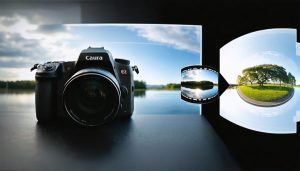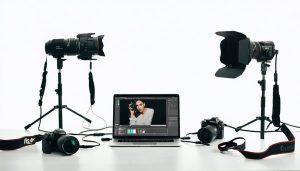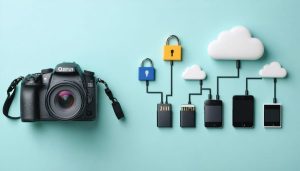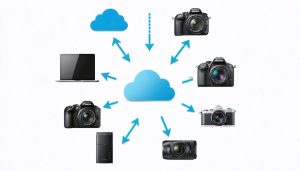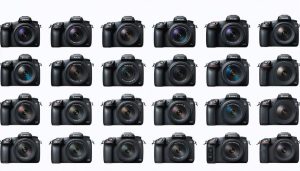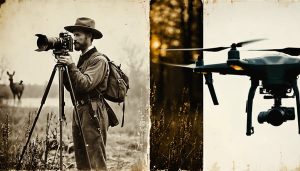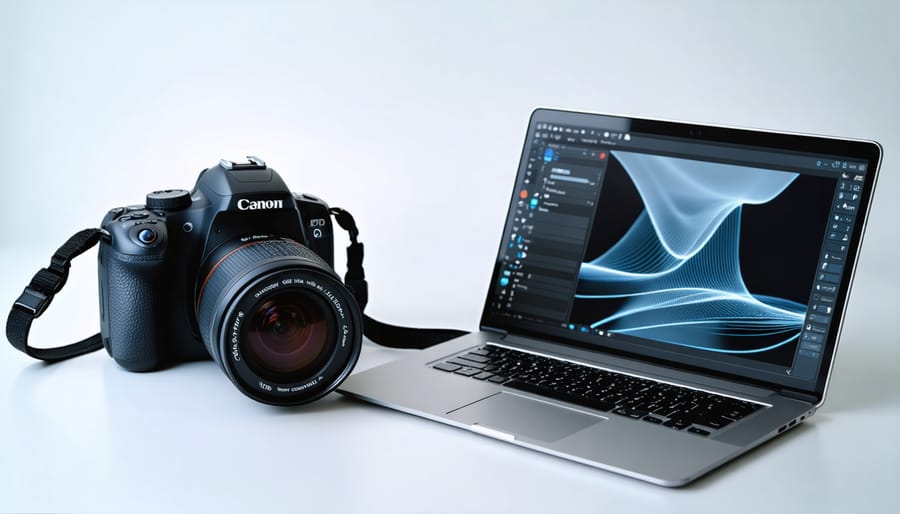
Transform your photography studio into a professional powerhouse by connecting your camera directly to your computer through tethering software. This real-time connection enables instant image preview, remote camera control, and helps streamline your photo editing workflow with unprecedented precision. Whether shooting in a controlled studio environment or on location, tethering software bridges the gap between capture and post-processing, offering photographers immediate feedback and enhanced creative control.
Leading solutions like Capture One Pro, Adobe Lightroom Classic, and digiCamControl have revolutionized how professionals approach their shoots, enabling instant client preview, automated file organization, and sophisticated exposure adjustments without touching the camera. The ability to instantly verify focus, composition, and lighting on a larger screen has become indispensable for commercial, portrait, and product photographers who demand pixel-perfect results.
In today’s fast-paced photography industry, tethering isn’t just a luxury—it’s a fundamental tool that elevates the professional workflow, ensures technical accuracy, and delivers superior results for demanding clients. By implementing the right tethering solution, photographers can minimize reshoots, enhance collaboration, and maintain consistent quality across entire projects.
What Makes Tethering Software Essential
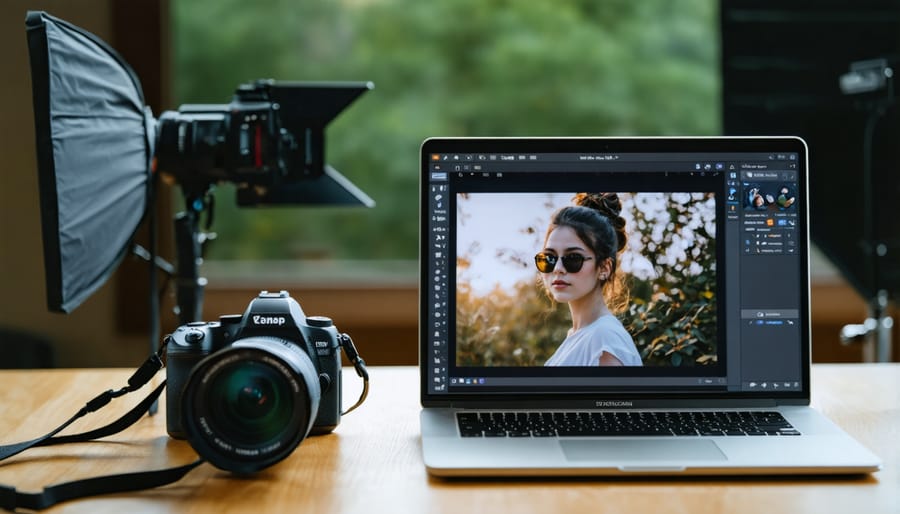
Real-Time Image Review
One of the most compelling advantages of tethering software is the ability to instantly review your images on a larger screen. Instead of squinting at your camera’s small LCD display, you can evaluate your shots on your computer monitor or tablet, where every detail becomes crystal clear. This immediate feedback is invaluable during photo shoots, allowing you to spot issues with focus, lighting, or composition that might otherwise go unnoticed until post-processing.
Many tethering applications offer tools for real-time image assessment, including focus checking, histogram analysis, and exposure warnings. You can zoom in to check critical focus areas or quickly compare multiple shots side by side. This instant review capability is particularly valuable in studio settings, where clients or art directors can provide immediate feedback on images as they’re captured.
The real-time preview also helps maintain shooting momentum. Rather than repeatedly checking the camera’s display and breaking your connection with the subject, you can maintain eye contact while glancing at the larger screen between shots. This workflow efficiency often results in better rapport with subjects and more natural expressions in portrait sessions.
Remote Camera Control
One of the most powerful features of tethering software is its ability to control your camera remotely from your computer. Using real-time camera control software, photographers can adjust crucial settings like aperture, shutter speed, and ISO without touching their camera. This capability is particularly valuable in studio environments where your camera might be mounted high on a boom or in awkward positions.
Imagine changing your exposure settings, triggering the shutter, and reviewing images instantly – all from your laptop. Most modern tethering solutions offer intuitive interfaces that mirror your camera’s physical controls, making the transition to computer control feel natural. You can even set up automated bracketing sequences, intervalometer functions, and focus stacking without additional hardware.
Advanced features often include live view streaming, which lets you compose and focus with precision on a larger screen. This is especially helpful for macro photography or detailed product shots where precise focusing is crucial. Some software even allows for sophisticated focus peaking and zebra patterns, tools traditionally found only in high-end cameras.
Popular Tethering Software Solutions
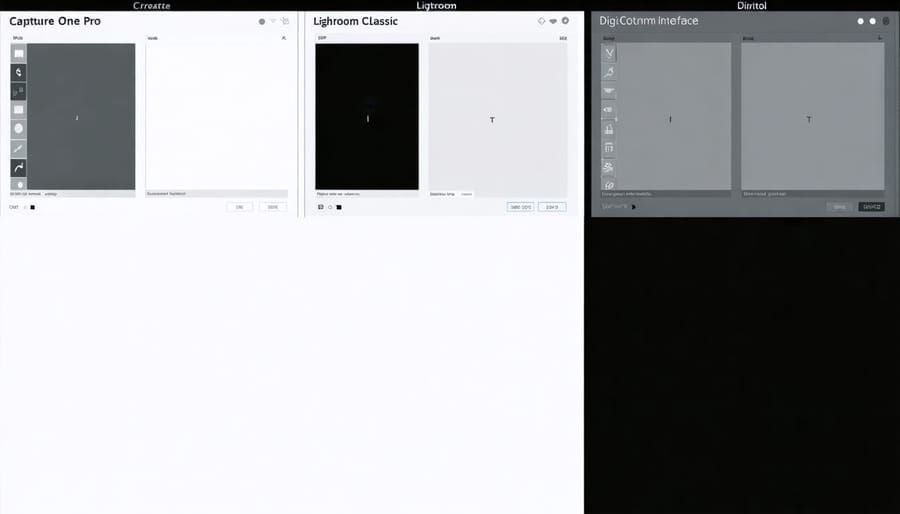
Capture One Pro
Capture One Pro stands as a powerhouse in professional tethering solutions, offering photographers robust camera software integration and exceptional image quality. The software supports a wide range of professional cameras, particularly excelling with Phase One, Sony, and Fujifilm systems, while also working seamlessly with Canon and Nikon.
What sets Capture One Pro apart is its superior color handling and customizable workspace. Photographers can create personalized keyboard shortcuts, tool arrangements, and custom overlays for precise composition during tethered shoots. The software’s live view feature provides real-time focus adjustments and composition previews, making it invaluable for studio work.
The program’s session-based workflow allows photographers to organize shoots into contained projects, perfect for client work. Its robust catalog system helps manage larger collections while maintaining swift performance. The software’s tethering connection is notably stable, with automatic backup features ensuring no images are lost during transfer.
Advanced features include layer-based editing, focus masking, and exposure warnings that update in real-time. The software’s capture pilot feature enables clients to view images on their mobile devices as they’re shot, streamlining the approval process during commercial shoots.
While the learning curve might be steeper than some alternatives, the investment in mastering Capture One Pro pays off in workflow efficiency and image quality.
Adobe Lightroom Classic
Adobe Lightroom Classic stands as a cornerstone in many photographers’ workflows, offering seamless tethering capabilities that integrate perfectly with its robust editing and organizing features. When shooting tethered, images transfer directly from your camera to Lightroom Classic, appearing instantly in your catalog for immediate review and processing.
The software supports a wide range of Canon and Nikon cameras, with particularly strong integration for these major brands. Setting up tethered shooting is straightforward: simply connect your camera via USB, choose “Start Tethered Capture” from the File menu, and you’re ready to go. Photographers can create custom naming conventions, apply developing presets during import, and even control basic camera settings directly from the software.
One of Lightroom Classic’s strongest advantages is its seamless connection to the broader Adobe Creative Cloud ecosystem. Images captured through tethering can be immediately synchronized across devices or shared with clients through online galleries. The software also offers robust file handling, allowing you to automatically back up images to a second location during tethered capture.
For studio photographers, Lightroom Classic provides essential tools like live view (for supported cameras), focus checking, and the ability to adjust camera settings without touching the camera. While it may not offer the most extensive tethering features compared to specialized software, its integration with the editing workflow makes it an efficient choice for photographers already invested in the Adobe ecosystem.
digiCamControl
For photographers seeking a robust free alternative to commercial tethering solutions, digiCamControl stands out as a powerful open-source option. This Windows-based software supports an impressive range of DSLR and mirrorless cameras from major manufacturers like Nikon, Canon, and Sony, making it accessible to most photographers regardless of their gear.
What makes digiCamControl particularly appealing is its comprehensive feature set. Users can control virtually every aspect of their camera remotely, including aperture, shutter speed, ISO, and focus adjustments. The live view functionality allows for precise composition and focus checking directly from your computer screen, while the built-in focus stacking capabilities are especially valuable for macro and product photographers.
The software includes practical features like interval shooting for time-lapse photography, bracketing controls for HDR work, and the ability to save captured images directly to both the camera’s memory card and computer simultaneously. Its user interface, while not as polished as some commercial alternatives, is intuitive enough for most photographers to grasp quickly.
Advanced users will appreciate the software’s customizable hotkey support and the ability to run custom scripts, enabling automated workflows. The active community behind digiCamControl regularly updates the software, fixing bugs and adding support for new camera models, ensuring its longevity as a reliable tethering solution.
Setting Up Your Tethering Workflow
Essential Hardware
To get started with tethered photography, you’ll need several key pieces of hardware to ensure a reliable connection between your camera and computer. The most crucial component is a high-quality data cable – typically USB or Firewire, depending on your camera model. For optimal performance, always use manufacturer-recommended cables and keep spares handy as part of your essential equipment maintenance routine.
Cable length matters significantly in tethered shooting. While standard 3-foot cables work for close setups, professional photographers often need 15-foot or longer cables for studio flexibility. Consider using active extension cables or repeaters for distances beyond 15 feet to maintain signal integrity.
A sturdy laptop stand or tethering table is essential for protecting your equipment and ensuring a comfortable workflow. Look for options with adjustable height and stable construction. Cable management solutions, such as clips or velcro straps, help prevent accidental disconnections and protect both your cables and port connections.
Power management is another critical consideration. Since tethered shooting typically demands more battery power, invest in an AC adapter for your camera or extra batteries. Similarly, ensure your laptop has reliable power access – either through direct AC connection or extended battery packs.
For outdoor shoots, consider weather protection for your setup. A good laptop sun hood helps with screen visibility, while weather-sealed cable connections and protective covers shield your equipment from the elements. Additionally, a backup external hard drive provides extra security for your tethered workflow, ensuring no images are lost due to technical issues.
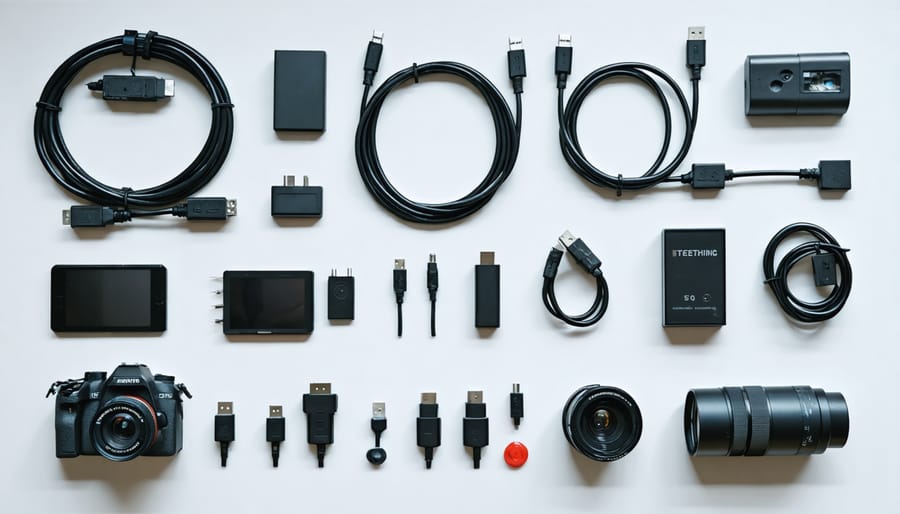
Common Setup Issues
When setting up tethered shooting, photographers often encounter several common issues that can be frustrating but are typically easy to resolve. One of the most frequent problems is connection drops, which usually stem from loose or damaged USB cables. Always invest in high-quality, well-shielded cables and consider using a cable with a length under 15 feet to maintain signal stability.
Another prevalent issue is software recognition failures, where your computer doesn’t detect the camera. This can often be resolved by ensuring your camera’s firmware is up to date and checking that your tethering software supports your specific camera model. Sometimes, simply turning the camera off and on again while connected can resolve recognition problems.
Memory card conflicts can also cause hiccups in your tethering workflow. Some cameras struggle when a memory card is inserted while tethering. Try removing the memory card or adjusting your camera’s settings to prioritize tethered transfer over card storage.
Battery drain is another consideration, as tethered shooting typically consumes more power than standard operation. Keep your camera connected to AC power when possible, or have multiple fully-charged batteries on hand for longer sessions.
If you’re experiencing slow transfer speeds, check that your USB ports are operating at full capacity. Avoid using USB hubs when possible, and connect directly to your computer’s USB ports. For Mac users, permissions issues can sometimes block tethering software from accessing the camera – ensuring your software has the necessary permissions in System Preferences can quickly resolve this.
Remember to close other programs that might be accessing your camera, as this can cause conflicts with your tethering software.
Advanced Tethering Techniques
Studio Integration
Integrating tethering into your studio workflow can dramatically streamline your photography process while enhancing collaboration with clients and team members. The key is to establish a systematic approach that combines efficient capture, instant review, and a reliable photo backup workflow.
Start by setting up a dedicated tethering station with your computer positioned within easy reach of your shooting area. Consider using a rolling cart or sturdy table that allows you to move the setup as needed. Cable management is crucial – use cable ties or guides to prevent tripping hazards and protect your equipment from accidental disconnections.
Many studios incorporate a second monitor or large display for client viewing. This setup enables art directors and clients to review images in real-time while you maintain control of the primary workspace. Some photographers even extend this functionality by using tablet devices for remote viewing, allowing clients to mark their favorite shots or make notes without interrupting the shoot.
Organization is vital when shooting tethered. Create a structured folder system for each client or project, and use consistent naming conventions for quick file retrieval. Most tethering software allows you to apply basic metadata and ratings during capture, saving valuable time in post-production.
For maximum efficiency, set up custom presets in your tethering software for different types of shoots. These might include specific color profiles, file naming patterns, or automatic backup settings. Remember to test your entire workflow before important shoots, ensuring all components work seamlessly together and your team knows their roles in the process.
Client Collaboration
One of the most powerful advantages of tethered shooting is the ability to collaborate with clients in real-time during photo sessions. Instead of huddling around the small camera screen, clients can view images on a larger display immediately after capture, leading to more productive and efficient shoots.
When working with art directors, models, or commercial clients, this immediate feedback becomes invaluable. Clients can quickly approve shots or request adjustments to lighting, composition, or styling while the set is still in place. This real-time collaboration eliminates the need for costly reshoots and ensures everyone is aligned with the creative vision.
Many tethering software solutions offer tools specifically designed for client interaction. Features like rating systems, color coding, and annotation tools allow clients to mark their preferred shots or add specific comments directly on the images. Some applications even provide remote viewing capabilities, enabling clients to monitor the shoot from different locations through secure web links.
For portrait photographers, showing clients their images during the session can boost confidence and engagement. When subjects can see how great they look, they often become more relaxed and natural in front of the camera. Wedding photographers can benefit similarly by showing key shots to the couple or family members to ensure they’re capturing all the desired moments and compositions.
To maintain a professional workflow while collaborating, consider setting up a dedicated client viewing station separate from your main working screen. This setup allows you to maintain control over your technical process while giving clients the visibility they need. Remember to manage expectations and establish clear communication protocols before the shoot to ensure a smooth collaborative experience.
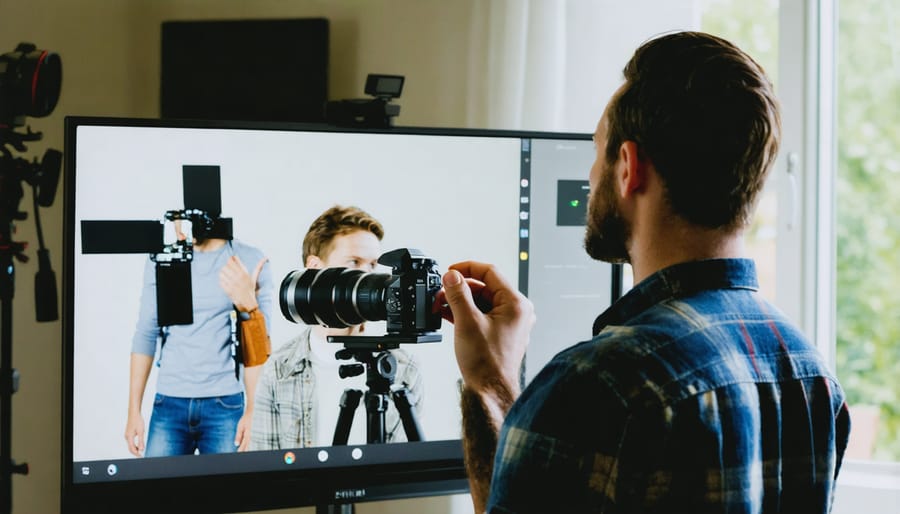
Tethered shooting represents a significant step forward in professional photography workflow, offering unprecedented control, precision, and efficiency. By implementing a tethered setup, you’ll not only enhance your technical capabilities but also elevate the overall quality of your work and client experience.
Whether you choose industry standards like Capture One and Lightroom or opt for specialized solutions like qDslrDashboard or digiCamControl, the key is finding software that aligns with your specific needs and working style. Remember that while the initial setup may require some patience and technical understanding, the benefits far outweigh the learning curve.
Consider starting with basic tethering in your home studio, gradually expanding your setup as you become more comfortable with the workflow. Many photographers find that once they’ve experienced the advantages of instant review on a larger screen, real-time adjustments, and seamless file organization, it becomes an indispensable part of their photography process.
Don’t let technical concerns hold you back from exploring tethered shooting. Modern software solutions have become increasingly user-friendly, and most offer excellent documentation and community support. Take the first step by experimenting with your existing equipment and free software options, then upgrade as your needs evolve.
As technology continues to advance, tethering will only become more integral to professional photography. By embracing this workflow now, you’re investing in skills and capabilities that will serve you well into the future.

